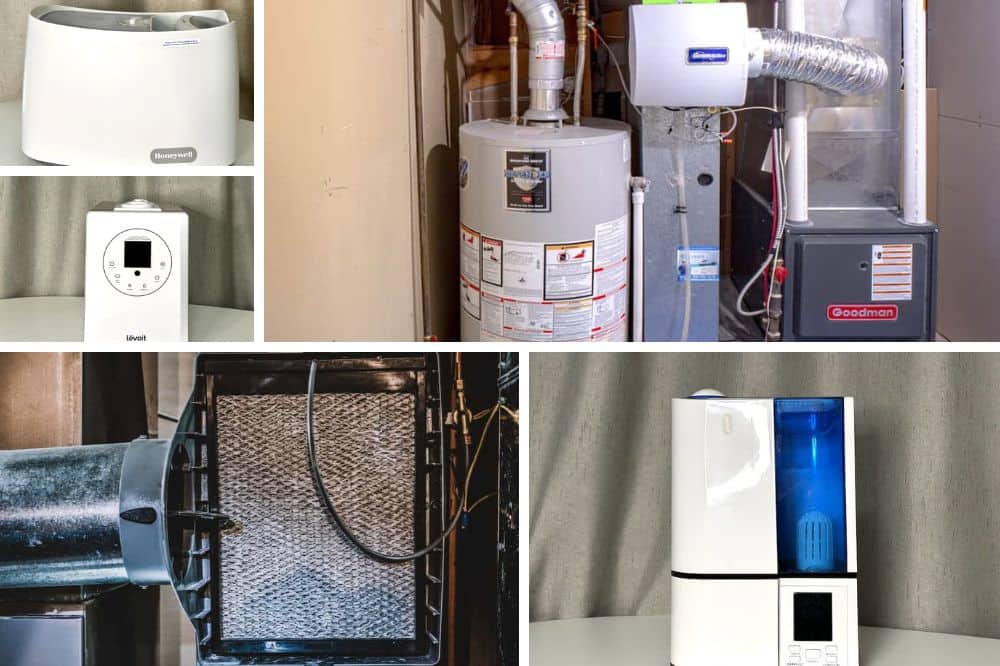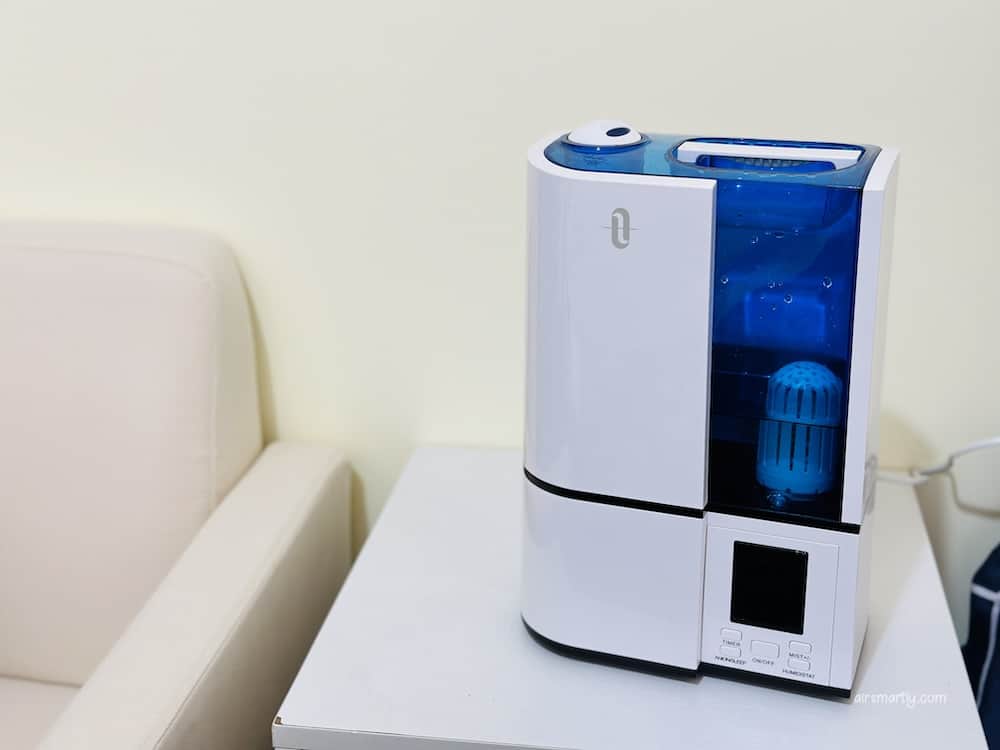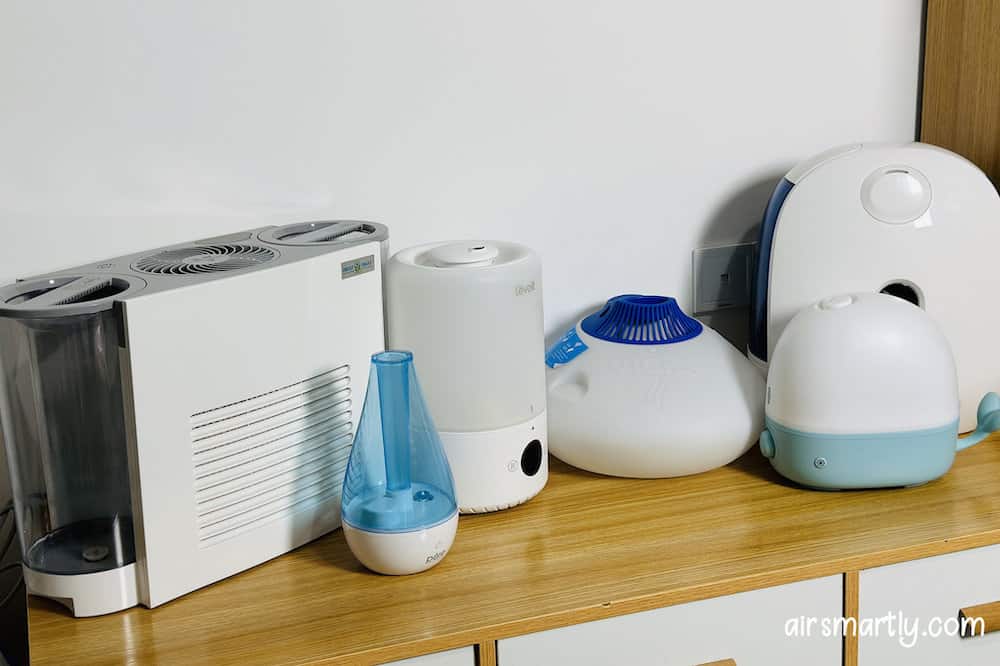While humidifiers are simple household appliances, they come in various types. If you’re not familiar with the industry, it can be challenging to determine which type is the right fit for your needs.
Like many others, you may prefer to know the specific type you require before making a purchase. In this post, I will explain the main types of humidifiers in a simple manner, allowing you to understand the differences, their pros, and cons, and make an informed decision quickly.
Let’s dive straight into it!
Portable humidifier
The first question you need to consider is where you intend to use your humidifier. If you plan to use it primarily in your bedroom, your child’s room, or even during your travel trips, then a portable humidifier would be the ideal choice.
As the name suggests, a portable humidifier is designed to work independently and is suitable for covering relatively small spaces. It is typically compact, budget-friendly, and easy to move around. They come in various sizes, with some models being incredibly tiny, making them convenient to carry while traveling.
On the other hand, if you wish to improve the indoor humidity level for your entire house, a whole-house humidifier would be more appropriate, and I’ll discuss that option in more detail later.
Portable humidifiers can be categorized in different ways. Typically, people like to differentiate them based on the technologies they use and the temperature of the mist they produce.
By technologies
1. Ultrasonic humidifier

Ultrasonic humidifier is the most popular type of humidifier in the market. They have a built-in metallic diaphragm, which can break down water into a fine mist and disperse it into the air through high-speed vibration.
Humans are unable to hear the high-speed vibration. Therefore, ultrasonic humidifiers operate quietly. Since this technology has become widespread, ultrasonic humidifiers are often available at a lower price tag.
However, contaminants in the water can also be released into the air along with the vibrations. Therefore, it is essential to ensure that the water used in the humidifier is clean and replaced regularly. Otherwise, bacteria and mold spores present in the water may enter your room and pose health risks.
Moreover, mineral buildup can lead to the formation of white dust, which may settle on furniture and the floor, potentially triggering respiratory issues and infections.
2. Evaporative humidifier

Evaporative humidifiers are trending these days. Water can evaporate naturally. The evaporative humidifier makes use of a fan or a plastic evaporator to accelerate the evaporation process so as to add moisture to the space.
A significant advantage of most evaporative humidifiers is the inclusion of a wick filter, which helps to remove impurities from the water. Meanwhile, the mineral deposits will not get into the air via evaporation, so you don’t need to worry about the issue of white dust.
However, the operation of a fan or evaporator can produce a certain amount of noise. Additionally, the filter requires replacement every one or two months, which can significantly increase the ongoing cost.
See also:
Evaporative vs Ultrasonic Humidifiers: What’s The Difference?
3. Vaporizer

Have you seen the water vapor released from boiling water? Vaporizers work on a similar principle. By heating the water through carbon electrodes connected to the electricity supply, they can produce a significant amount of warm water steam.
Because of the simple mechanism, vaporizers are usually cheaper than other types of humidifiers. The water vapor is also free of harmful microbes. However, you should wait a few minutes before they start emitting water vapor. Since the water inside is hot, you should exercise caution while using them.
By mist temperature
4. Cool mist humidifier

A cool mist humidifier is a type of humidifier that adds cool moisture to the air, thereby increasing indoor humidity levels. Based on what we have discussed above, ultrasonic humidifiers and evaporative humidifiers fall under the category of cool mist humidifiers.
Since the water temperature in cool mist humidifiers is low, they do not cause any scalds or burns, making them a safe choice for use around kids and pets. Additionally, they are usually energy-efficient because they do not require electricity to heat the water.
But again, bacteria and mold spores can get into the space easily if you are using a cool mist ultrasonic humidifier.
5. Warm mist humidifier

A warm mist humidifier is a device that produces warm mist or steam. Vaporizers are warm mist humidifiers.
Furthermore, some ultrasonic humidifiers can also emit warm mist. They achieve this by incorporating a small heater inside that warms the water to around 60 degrees, and then the warm water is transformed into a warm mist via the diaphragm.
Many people prefer a warm mist humidifier because it can slightly increase the room temperature in winter. Additionally, since bacteria can be killed through the heating process, warm mist humidifiers are more compatible with tap water.
As for the effect of relieving symptoms, there is currently insufficient evidence to determine which type of humidifier is better. However, when using any humidifier, it’s crucial to keep it away from family members and pets to prevent the risk of burns and scalds.
See also:
Cool Mist vs. Warm Mist Humidifier for Sinus Problems
Whole house humidifier
A whole-house humidifier, also known as a central humidifier, is a type of humidifier that can increase the humidity level of your whole house by adding moisture to the HVAC system.
Installing a whole-house humidifier can be expensive, but it can provide the proper humidity level you need wherever you stay at home. By increasing humidity levels, you may also save some energy and money on your heating system.
1. Bypass humidifier

A bypass humidifier is a type of humidifier that connects to an air handler or the return of your furnace. It requires additional ductwork and operates only when the furnace is on.
When warm air passes through the bypass humidifier, it adds moisture to the air, which is then distributed throughout the entire house.
Bypass humidifiers typically have a lower price tag but incur higher installation costs. It’s important to replace the filter regularly to maintain its efficiency and ensure clean, healthy air circulation.
2. Fan-powered humidifier

Fan-powered humidifiers have a built-in fan that draws and pushes air through the unit. Consequently, they can operate independently even when the furnace is off. They do not require an extra duct and can be installed in more compact spaces.
Due to the presence of a fan, fan-powered humidifiers generally offer better humidifying performance compared to bypass humidifiers. The fan aids in distributing moisture more effectively, resulting in improved humidity levels throughout the entire house.
Moreover, fan-powered humidifiers do not require a filter, reducing maintenance needs, and have a lower likelihood of breeding bacteria and mold due to the absence of standing water.
Since it has a more complex construction, a fan-powered humidifier can cost more than a bypass humidifier. However, it is generally easier to install despite the higher initial cost.
3. Steam humidifier
The steam humidifier is similar to the vaporizer we discussed earlier, but it operates in tandem with the HVAC system.
It is equipped with a large water reservoir to store and heat the water. The warm water steam is then distributed throughout the HVAC system, effectively adding moisture to the air in your home.
There is no need to worry about harmful microbes, as the heating process effectively eliminates them. The humidifying performance is also excellent. However, you can expect to pay more for electricity bills.
Sum up
Categorizing humidifiers in different ways can make it challenging to decide which type is the best fit for your needs.
The first step is to determine whether you need a portable humidifier or a whole-house humidifier. If you’re a renter or only need to humidify specific rooms, a portable humidifier is a suitable choice.
On the other hand, if you own a house and desire consistent humidity levels throughout your entire home, a whole-house humidifier is an excellent option.
Then you should consider your health condition and schedual. For example, for a light sleeper, ultrasonic humidifier is better because it is quieter. But for a people with asthma, an evaporative humidifier would be a safer choice because it will not spread bacteria and mold spores in the air.
Taking into account your family members are also crucial. For people who have children or pets at home, a cool mist humidifier is much safer.
If you have already decided on the type of humidifier to purchase, why not check reviews on our site to find a suitable model for your needs.





